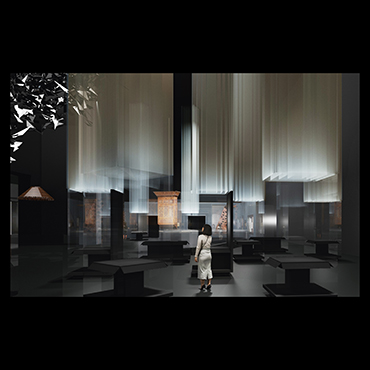The second edition of the Islamic Arts Biennale is titled Wama Bainahuma (“And All That Is in Between”). This is a phrase that recurs at least 20 times in the Qur’an, in almost every case preceded by the words Al-Samawat wal ‘Ardh (the heavens and the earth). Implicitly, then, it covers every element of God’s creation. Wama Bainahuma explores different ways in which we attempt to comprehend and acknowledge the Divine creation through different faculties – through engaging our hearts, minds, and hands.
With more than 500 objects and more than 30 contemporary artworks on view, the 2025 Islamic Arts Biennale can be experienced as several separate but complementary zones of exploration.
The first section, called AlBidayah (The Beginning), unites two realms profoundly sacred to Muslims—the Word of Allah and the House of Allah, both of which inspire us to look beyond the material and contemplate what makes the sacred sacred.
The second zone, AlMadar (The Orbit), showcases an initiative that promotes collaboration and dialogue between institutions and individuals within the Kingdom and around the world. AlMadar presents more than 250 objects from over 30 partner institutions from across more than 20 countries. This year, it explores the fundamental role of numbers in Islamic arts and culture.
AlMuqtani (Homage) celebrates the contribution made toward the understanding of Islamic civilization by two outstanding collections of works of art: The Al Thani Collection and The Furusiyya Art Foundation. Founded by Sheikh Hamad bin Abdullah Al Thani, The Al Thani Collection is characterized by a taste for precious materials and virtuosic artistry, with a particular focus on jeweled objects. The Furusiyyah Art Collection, created by Rifaat Medhat Sheikh El Ard is renowned for metalwork, especially works of art associated with horsemanship and the chivalric arts.
In the landscape beyond the galleries, defined by the rhythmic tent structure of the Hajj Terminal, AlMidhallah (The Canopy) displays contemporary installations, many specially commissioned from artists from across the Middle East and beyond. Taking inspiration from the forms and philosophies of the traditional Islamic garden – a symbol of paradise and a place where the heavenly and earthly meet – the artworks here will address community, restoration and repair, knowledge and inspiration in relation to pressing questions of today, from the voicing of underrepresented histories to the search for a sustainable future for humans and all life..
Lastly, the Biennale also consists of two pavilions dedicated permanently to Makkah AlMukarramah and Al-Madinah AlMunawwarah.
AlMukarramah reflects on the powerful dynamic between Makkah al-Mukarramah’s centrality and universality, bringing together historical items associated with the Ka‘bah, rare early photographs and film, and a contemporary art installation.
AlMunawwarah explores the radiant legacy of Al-Madinah al-Munawwarah—including a group
of previously unknown gold-embroidered textiles—and in its design reflects the celebrated warmth of Madinah’s atmosphere.
We hope you enjoy your time exploring the Islamic Arts Biennale!

